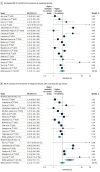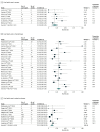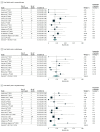Differences in Outcomes and Factors Associated With Mortality Among Patients With SARS-CoV-2 Infection and Cancer Compared With Those Without Cancer: A Systematic Review and Meta-analysis
- PMID: 35532936
- PMCID: PMC9086843
- DOI: 10.1001/jamanetworkopen.2022.10880
Differences in Outcomes and Factors Associated With Mortality Among Patients With SARS-CoV-2 Infection and Cancer Compared With Those Without Cancer: A Systematic Review and Meta-analysis
Abstract
Importance: SARS-CoV-2 infection has been associated with more severe disease and death in patients with cancer. However, the implications of certain tumor types, treatments, and the age and sex of patients with cancer for the outcomes of COVID-19 remain unclear.
Objective: To assess the differences in clinical outcomes between patients with cancer and SARS-CoV-2 infection and patients without cancer but with SARS-CoV-2 infection, and to identify patients with cancer at particularly high risk for a poor outcome.
Data sources: PubMed, Web of Science, and Scopus databases were searched for articles published in English until June 14, 2021. References in these articles were reviewed for additional studies.
Study selection: All case-control or cohort studies were included that involved 10 or more patients with malignant disease and SARS-CoV-2 infection with or without a control group (defined as patients without cancer but with SARS-CoV-2 infection). Studies were excluded if they involved fewer than 10 patients, were conference papers or abstracts, were preprint reports, had no full text, or had data that could not be obtained from the corresponding author.
Data extraction and synthesis: Two investigators independently performed data extraction using the Preferred Reporting Items for Systematic Reviews and Meta-analyses (PRISMA) reporting guideline. Meta-analysis was performed using a random-effects model.
Main outcomes and measures: The difference in mortality between patients with cancer and SARS-CoV-2 infection and control patients as well as the difference in outcomes for various tumor types and cancer treatments. Pooled case fatality rates, a random-effects model, and random-effects meta-regressions were used.
Results: A total of 81 studies were included, involving 61 532 patients with cancer. Among 58 849 patients with available data, 30 557 male individuals (52%) were included and median age ranged from 35 to 74 years. The relative risk (RR) of mortality from COVID-19 among patients with vs without cancer when age and sex were matched was 1.69 (95% CI, 1.46-1.95; P < .001; I2 = 51.0%). The RR of mortality in patients with cancer vs control patients was associated with decreasing age (exp [b], 0.96; 95% CI, 0.92-0.99; P = .03). Compared with other cancers, lung cancer (RR, 1.68; 95% CI, 1.45-1.94; P < .001; I2 = 32.9%), and hematologic cancer (RR, 1.42; 95% CI, 1.31-1.54; P < .001; I2 = 6.8%) were associated with a higher risk of death. Although a higher point estimate was found for genitourinary cancer (RR, 1.11; 95% CI, 1.00-1.24; P = .06; I2 = 21.5%), the finding was not statistically significant. Breast cancer (RR, 0.51; 95% CI, 0.36-0.71; P < .001; I2 = 86.2%) and gynecological cancer (RR, 0.76; 95% CI, 0.62-0.93; P = .009; I2 = 0%) were associated with a lower risk of death. Chemotherapy was associated with the highest overall pooled case fatality rate of 30% (95% CI, 25%-36%; I2 = 86.97%; range, 10%-100%), and endocrine therapy was associated with the lowest at 11% (95% CI, 6%-16%; I2 = 70.68%; range, 0%-27%).
Conclusions and relevance: Results of this study suggest that patients with cancer and SARS-CoV-2 infection had a higher risk of death than patients without cancer. Younger age, lung cancer, and hematologic cancer were also risk factors associated with poor outcomes from COVID-19.
Conflict of interest statement
Figures




References
Publication types
MeSH terms
Grants and funding
LinkOut - more resources
Full Text Sources
Medical
Miscellaneous

